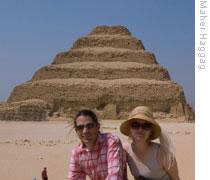VOA慢速英语-EXPLORATIONS - A Visit to the Cultural Treasures in
时间:2019-01-11 作者:英语课 分类:VOA慢速英语2008年(七)月
For centuries, the buildings of ancient Egypt have captured the attention of historians 1, artists, and travelers. Transcript 2 of radio broadcast:
15 July 2008
VOICE ONE:
I'm Steve Ember.
VOICE TWO:

Cairo at sunset
And I'm Faith Lapidus with EXPLORATIONS in VOA Special English. Today, we continue our travels through Egypt to explore one of the greatest civilizations in human history. Last week, we visited the Nile River valley to see the art and architecture of ancient Egypt.
Today, we explore the buildings of ancient Egyptians in and around Cairo. And, we visit other more modern cultural treasures in the capital city.
(MUSIC)
VOICE ONE:
Welcome to Cairo, the largest city in Africa and the Middle East. This huge city is home to about seven million people. Cairo is equally great for its many traditions, cultures, and monuments. We begin our visit in the center of the city on the banks of the Nile river.
(SOUND: Traffic)
Looking at the countless 3 buildings, cars, people, and boats it is hard to imagine the historical roots of this modern place. The beginning of Cairo as a city dates to the year nine sixty-nine when Muslim invaders 4 from Tunisia took control of the area. The word Cairo comes from the Arabic word "al-Qahira" meaning "the victorious 5."
VOICE TWO:
Many rulers, such as the Fatimids, the Ayyubids, the Mamelukes and the Ottomans, controlled Egypt over the centuries. Starting in the late nineteenth century, Britain controlled the country for about seventy years. Each of these cultures left its mark on the culture and building design of Cairo.
In the late eighteenth century, the French general Napoleon Bonaparte briefly 6 took control of Egypt. He brought with him over one hundred and fifty experts and scientists to document the monuments, arts, plants and animals of Egypt. Over several years, thousands of artists worked to put together the collection of books called the "Description de l'Egypte."
VOICE ONE:
For many Europeans, these detailed 7 descriptions brought to life a culture that was unknown to them and very exciting. By the middle of the nineteenth century, Egypt became a popular destination for European travelers, writers, and artists. Ancient Egypt influenced European architecture, art and opera. This interest also had some unfortunate effects. European travelers in Egypt often took ancient treasures illegally. Many important objects ended up in the national museums of Britain, France and Germany.
VOICE TWO:
In eighteen thirty-five, the Egyptian government started the Egyptian Antiques 8 Service. Its aim was to stop the stealing of ancient objects and gather a national collection for a museum. Today, visitors can spend many hours enjoying the Egyptian Museum in Cairo. It houses an estimated one hundred twenty thousand objects from all periods of ancient Egyptian history.
VOICE ONE:

Tutankhamun's gold mask
One of the most popular rooms in the museum contains the funeral objects of the Egyptian pharaoh Tutankhamun. Last week we visited his burial site. But in the museum, visitors can see the strikingly 9 beautiful objects with which he was buried three thousand three hundred years ago. The skill and imagination of the artisans that made Tutankhamun's treasures are extraordinary.
For example, his detailed death mask weighs eleven kilograms and is made from jewels and solid gold. It gives a stylized image of the young ruler's face.
(MUSIC)
VOICE TWO:
Visiting the area of the city called Old Cairo provides an interesting lesson in religious history. Before Islam came to Egypt, the main religion of the area was Christianity. Egyptian Christians 10 are known as Copts. You can visit the Coptic religious center known as the Hanging Church. This ninth century structure was built on top of an ancient Roman gate.
Or you can visit the third century Church of Saint 11 Sergius. Many people believe the church is built over a cave where Mary, Joseph and the baby Jesus hid while fleeing from Judea. Nearby is the oldest Jewish religious center in Egypt. The Ben Ezra Synagogue dates back to the ninth century.
VOICE ONE:
In another area known as Islamic Cairo, there are many historically important mosques 13.
(SOUND: Call to Prayer)
For example, the Al-Azhar Mosque 12 has been a religious center and university for over a thousand years. The Mosque of Sayyidna al-Hussein is one of the most holy Islamic buildings in Egypt. It is believed to be the burial place of the head of Hussein, the grandson of the Prophet 14 Muhammed.
VOICE TWO:

Entering the Khan al-Khalili
For an unforgettable shopping experience, you can visit the Khan al-Khalili. Since the fourteenth century, the traders of Cairo have been selling their goods there. Today, you can buy anything from jewelry 15 and belly-dancing costumes to spices and floor coverings.
Inside the market area, visitors can stop at the Mahfouz Café to enjoy some mint 16 tea or smoke a sheesha pipe. The café was named after the Nobel Prize winning Egyptian writer Naguib Mahfouz who grew up in this part of the city. His stories capture the sights and sounds of Cairo and its people.
(MUSIC)
VOICE ONE:
No visit to Cairo could be complete without a trip to see some of the most famous buildings in the world. In the area of the city called Giza, three huge stone pyramids rise out of the desert sands. For thousands of years, these extraordinary buildings have served as funeral monuments honoring three ancient Egyptian kings.
The nineteenth century French writer Gustave Flaubert wrote this about the pyramids after visiting them: "Khafre's pyramid seems to me inordinately 17 huge and completely sheer 18; It's like a cliff, like a thing of nature, a mountain …"
His words help express the unbelievable size and power of these limestone 19 buildings.
VOICE TWO:

The Great Pyramid of Khufu
The oldest and largest is called the Great Pyramid of Khufu, built as the burial place for this ancient king. This tomb is the last survivor 20 of the Seven Wonders of the World. When it was built four thousand five hundred years ago, it stood one hundred forty-six meters tall. Experts estimate that about two million three hundred thousand limestone blocks were used to build this remarkable 21 tomb. And, each limestone block weighs two and one-half tons.
The famous statue of the Sphinx sits nearby. Experts still debate the age and meaning of this ancient statue, which has the head of a man and the body of a lion.
VOICE ONE:

The writer and her husband, Tim Rooney, at the Step Pyramid
Experts still do not know exactly how the ancient Egyptians were able to build such technically 22 perfect buildings. How were the ancient builders able to move the huge stone blocks from the quarries 23 where they were cut to the building area? How were they able to raise them to the higher levels of the monuments? And what kind of tools did these ancient builders use to cut stone as hard as granite 24?
VOICE TWO:
Over the centuries pyramidologists have developed many interesting theories about how the structures were built. Some believe they were built with help from alien creatures from space. Others believe slaves of the pharaoh were forced to build these structures. Our tour guide Maher Haggag has a different theory about why workers built these structures.
MAHER HAGGAG: "Slaves could have never ever created perfection 25 like this. It wasn't slavery, it was a privilege for them. People had a passion to build something like this. Just by their own bare hands. No technology had been involved, just faith and they loved what they'd been doing."
VOICE ONE:
Outside of Cairo, the ancient burial area of Saqqara helps explain the development of the pyramid structure. The architect Imhotep designed the Step Pyramid over four thousand six hundred years ago for the pharaoh Zoser. It is the first known stone monument ever built. Imhotep designed it so that Zoser's burial monument would last forever. Before, royal tombs were built with mud brick materials that were easily damaged over time.
VOICE TWO:
Imhotep's idea of stacking layers of stone led to the development of the pyramid tomb. From Saqqara you can look far off in the distance to see pyramids built for a later ruler of Egypt, Sneferu. The Bent 26 Pyramid starts at a sharp angle, then becomes more flat towards its top. Architects did not yet know the correct angle with which to build a stable pyramid. They tried again with the nearby Red Pyramid. This structure is considered the oldest true pyramid in the world.
VOICE ONE:

A felucca owner sailing on the Nile in Cairo
After a day exploring Cairo, there is nothing more relaxing than hiring a felucca boat to sail you up and down the Nile. As you watch the sun set on this magical city, you can think about its many cultural treasures, old and new.
(MUSIC)
VOICE TWO:
This program was written and produced by Dana Demange. I'm Faith Lapidus.
VOICE ONE:
And I'm Steve Ember. To see pictures of Egypt, visit our Web site, voaspecialenglish.com. Join us again next week for EXPLORATIONS in VOA Special English.
- Historians seem to have confused the chronology of these events. 历史学家好像把这些事件发生的年代顺序搞混了。
- Historians have concurred with each other in this view. 历史学家在这个观点上已取得一致意见。
- A transcript of the tapes was presented as evidence in court.一份录音带的文字本作为证据被呈交法庭。
- They wouldn't let me have a transcript of the interview.他们拒绝给我一份采访的文字整理稿。
- In the war countless innocent people lost their lives.在这场战争中无数无辜的人丧失了性命。
- I've told you countless times.我已经告诉你无数遍了。
- They prepared to repel the invaders. 他们准备赶走侵略军。
- The family has traced its ancestry to the Norman invaders. 这个家族将自己的世系追溯到诺曼征服者。
- We are certain to be victorious.我们定会胜利。
- The victorious army returned in triumph.获胜的部队凯旋而归。
- I want to touch briefly on another aspect of the problem.我想简单地谈一下这个问题的另一方面。
- He was kidnapped and briefly detained by a terrorist group.他被一个恐怖组织绑架并短暂拘禁。
- He had made a detailed study of the terrain.他对地形作了缜密的研究。
- A detailed list of our publications is available on request.我们的出版物有一份详细的目录备索。
- The room was furnished with antiques. 房间里摆放了古董。
- a priceless collection of antiques 价值连城的古文物收藏
- The quagga was a strikingly beautiful variant of the zebra. 斑驴是一种极美丽的斑马变种。
- The model strikingly confirms the potent effect of Himalaya-Tibet on the circulation. 该模式惊人的证明了喜马拉雅西藏高原对环流的重要影响。
- Christians of all denominations attended the conference. 基督教所有教派的人都出席了这次会议。
- His novel about Jesus caused a furore among Christians. 他关于耶稣的小说激起了基督教徒的公愤。
- He was made a saint.他被封为圣人。
- The saint had a lowly heart.圣人有谦诚之心。
- The mosque is a activity site and culture center of Muslim religion.清真寺为穆斯林宗教活动场所和文化中心。
- Some years ago the clock in the tower of the mosque got out of order.几年前,清真寺钟楼里的大钟失灵了。
- Why make us believe that this tunnel runs underneath the mosques? 为什么要让我们相信这条隧洞是在清真寺下?
- The city's three biggest mosques, long fallen into disrepair, have been renovated. 城里最大的三座清真寺,过去年久失修,现在已经修复。
- A prophet made a prophecy that the kingdom would fall.一位预言家预言那个王国将要灭亡。
- The pity is that you are not a prophet.可惜你不能未卜先知。
- The burglars walked off with all my jewelry.夜盗偷走了我的全部珠宝。
- Jewelry and lace are mostly feminine belongings.珠宝和花边多数是女性用品。
- But if you are determined to accumulate wealth, it isn't inordinately difficult. 不过,如果你下决心要积累财富,事情也不是太难。 来自互联网
- She was inordinately smart. 她非常聪明。 来自互联网
- He achieved his aim by sheer strength of will.他纯粹靠意志力达到了目的。
- I guess It'sheer waste of time arguing about it.看来争论这件事纯粹是浪费时间。
- Limestone is often used in building construction.石灰岩常用于建筑。
- Cement is made from limestone.水泥是由石灰石制成的。
- The sole survivor of the crash was an infant.这次撞车的惟一幸存者是一个婴儿。
- There was only one survivor of the plane crash.这次飞机失事中只有一名幸存者。
- She has made remarkable headway in her writing skills.她在写作技巧方面有了长足进步。
- These cars are remarkable for the quietness of their engines.这些汽车因发动机没有噪音而不同凡响。
- Technically it is the most advanced equipment ever.从技术上说,这是最先进的设备。
- The tomato is technically a fruit,although it is eaten as a vegetable.严格地说,西红柿是一种水果,尽管它是当作蔬菜吃的。
- This window was filled with old painted glass in quarries. 这窗户是由旧日的彩色菱形玻璃装配的。 来自《简明英汉词典》
- They hewed out the stones for the building from nearby quarries. 他们从邻近的采石场开凿出石头供建造那栋房子用。 来自辞典例句
- They squared a block of granite.他们把一块花岗岩加工成四方形。
- The granite overlies the older rocks.花岗岩躺在磨损的岩石上面。
- Their works reach to a great height of perfection.他们的作品到了极完美的境地。
- The picture wants something of perfection.这幅画还有些不够完美。